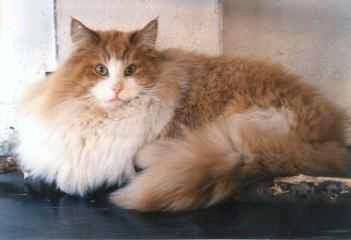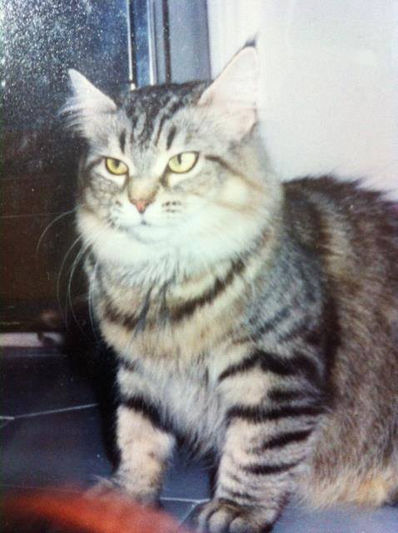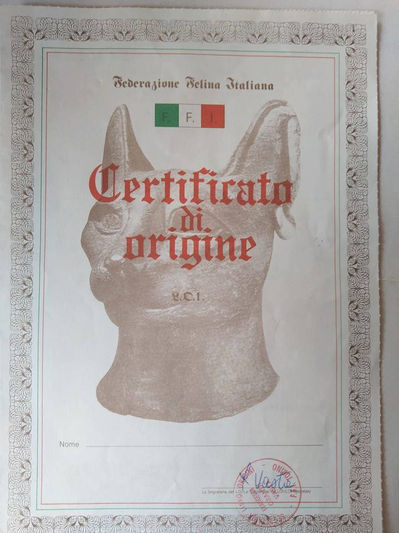The acronym “BARF” was first used by Debbie Tripp to distinguish those people who fed their dogs with fresh and raw meat and to distinguish between eating itself.
Literally “BARF” means: o Bones And Raw Foods.
The BARF diet consists of raw foods of animal origin, including bones and offal. For this we can also call it Raw Diet.
Making BARF however does not mean giving our cat raw meat to satiety or throwing leftovers from the table, but rather balancing a series of ingredients in order to try to simulate what it would eat in nature, in order to give our friend a complete and safe diet, but also satisfying and really beneficial for his health. "
I invite anyone reading this page to read and inquire elsewhere, possibly by contacting a veterinarian with experience in natural nutrition who will help you start in a balanced way.
I also invite you to read also articles regarding the doubts raised by vets opposed to barf, the possible dangers inherent in this type of diet, despite making a diet barf is absolutely possible and desirable, avoid 'do-it-yourself' as much as possible because damage in the long run can be serious and sometimes irreversible-_cc781905-5cde-3194_ bb3bbad-136 -5cde-3194-bb3b-136bad5cf58d_BARF or natural food, does not mean giving table scraps, nor random raw meat!
The acronym “BARF” was first used by Debbie Tripp to distinguish those people who fed their dogs with fresh and raw meat and to distinguish between eating itself.
Literally “BARF” means: o Bones And Raw Foods.
The BARF diet consists of raw foods of animal origin, including bones and offal. For this we can also call it Raw Diet.
Making BARF, however, does not mean giving our cat raw meat to satiety or throwing leftovers from the table, but rather balancing a series of ingredients in order to try to simulate what it would eat in nature, in order to give our friend a complete and safe diet, but also satisfying and really beneficial for his health. "
I invite anyone reading this page to read and inquire elsewhere, possibly by contacting a veterinarian with experience in natural nutrition who will help you start in a balanced way.
I also invite you to read also articles regarding the doubts raised by vets opposed to barf, the possible dangers inherent in this type of diet, despite making a diet barf is absolutely possible and desirable, avoid 'do-it-yourself' as much as possible because damage in the long run can be severe and sometimes irreversible-_cc781905-5cde-3194_bb3bbad-136 -5cde-3194-bb3b-136bad5cf58d_BARF or natural food, does not mean giving table scraps, nor random raw meat!

ALLEVAMENTO ETICO FAMIGLIARE DEL GATTO NORVEGESE DELLE FORESTE
“Il gatto che ha camminato nella Mitologia Nordica… e oggi cammina accanto a te.”
disir nornir
Benvenuto nella pagina della mia Famiglia Felina!
Welcome to my Feline Family page!
This site was created for the dissemination of knowledge and preservation of the biological diversity of the "Norwegian Forest" Natural Breed.
Cat breed, which until a few decades ago risked extinction and which today, without careful protection, risks losing its original appearance and genology. The births of our litters are aimed at " safeguarding the best subjects in terms of health, character and morphology ", to continue and pass on il" Norsk SkogKatt "(original Norwegian name) if you are interested do not hesitate to ask for information
IN ADOZIONE: Meravigliose Gatte adulte di Norvegese delle foreste di colore Bianco, Black silver, Blue silver, cercano una casa amorevole.
CONTATTACI Per maggiori informazioni e fotografie



"What does Safeguarding the Norwegian Cat mean?"
Above all it means respecting the great work that has been done in the past by great passionate breeders, trying to safeguard those genealogical lines that risk getting lost, thus impoverishing the genetics of this Magnificent Breed.
It means that my cats are first of all my family, companions of life, and it is with this spirit that I undertake to respect all their ethological needs, which are always put first, with respect to human needs.
My cats are free to climb, run, play, in large protected enclosures, without over-population, with areas organized in compliance with their ethological needs.
I live with my cats all stages of life, from birth, to pregnancy, to old age. If my neutered cats live well together with other fertile cats, they stay with me, otherwise they are entrusted to trusted families who will request them.
I use for them the best Natural food, BARF, based on meats for human use prepared by me.
I take care of my cats with a holistic approach, making use of specialized veterinarians
My Affix (Name of the Kennel) is registered in ANFI (Italian national feline federation) Anfi is one of the 41 members of the FIFe and is Legally recognized with DM 6/8/1997 Authorized to manage the Breed Book of the Purebred Cat with DM 9.6.2005 prot. 22790 modified with DM 13.10.2008 prot. 12953
"A heartfelt Thanksgiving goes to the families who have welcomed my puppies in the past but also those who will do so in the future; it is also thanks to you if I will be able to continue in the dream of Protecting this Magnificent Natural Breed"
Salvaguardia
storia e leggenda
The story of the Norwegian Forest cats was born many centuries ago, when the Nordic legends already saw it described in the mythological tales of which it is the protagonist next to the goddess Freya and the god Thor.
Around 1220, Snorri Sturluson, poet, historian, scholar and narrator of myths and legends, wrote the "EDDA" ("great-grandmother"), a text that describes the Nordic mythology of pagan Scandinavia, in which large sleeping cats are mentioned long in the tales of these two Nordic deities.




The first description of this breed dates back to 1599 when a naturalist, the Danish friar Peter Claus Friis, who lived for a long time in Norway, defined three categories of lynx: the wolf-lynx, the fox-lynx and the cat-lynx. last class plausibly indicated the progenitors of our Norwegian Forest cat.
The original name in Norwegian is “Norsk Skogkatt”: Norsk -> Norwegian, Skog -> Forest, Katt -> Cat.
The work "Norwegian Folk Tales" written by Asbjornsen and Moe was then published in 1835,
with which the Norwegian Forest Cat, becomes part of Norwegian literature and culture.
In the work “Norwegian folk tales” he is called "Huldrekat" ("huldre" = wood nymph) and described as a wood cat with a large and bushy tail.
In the fairy tales that were later handed down to the Brothers Grimm, this cat probably impersonated, with its long-haired culottes and the hind leg covered with undercoat, the well-known "Puss in Boots".
In 1912 the Norwegian author Gabriel Scott wrote a very popular children's book called "Sølvfaks" in which the protagonist of the story is a cat of the woods.
<script>
(function (i, s, o, g, r, a, m) {i ['GoogleAnalyticsObject'] = r; i [r] = i [r] || function () {
(i [r] .q = i [r] .q || []). push (arguments)}, i [r] .l = 1 * new Date (); a = s.createElement (o),
m = s.getElementsByTagName (o) [0]; a.async = 1; a.src = g; m.parentNode.insertBefore (a, m)
}) (window, document, 'script', '// www.google-analytics.com/analytics.js','ga');
ga ('create', 'UA-63548512-1', 'auto');
ga ('send', 'pageview');
</script>
Around 1930 some Scandinavian breeders took an active interest in this autochthonous feline and started a breeding with the aim of safeguarding the originality of the species, selecting the subjects for their morphology and thick fur, trying to preserve it from mating with cats to short-haired and other genetic contamination. Already since 1940, during the 2nd World War, this type of cat was used by the Danish army with specific functions entrusted to forest cats during postal transport for the protection of precious goods, parcels and dispatches from the systematic destruction of mice. Only in 1965 these cats, considered "postal officers", were deleted from government registers.
In 1943, a book entitled "Cats, wild animals and domestic friends" was published in Norway on the breeding of the Norwegian Forest Cat (authors Reidar and Lund), which aroused much interest in the fate of the national cat and in which the bases for the breeding of the Norwegian were treated:
In the years that followed, the search for absolutely pure subjects became the goal of enthusiasts who worked hard for the salvation of the breed against the looming danger of extinction caused by the extension of cities and the spread of short-haired cats.
The first representatives of this breed appeared on display in 1969 and in 1973 Helene Nordane and Edel Runas of the Norwegian Feline Federation began the first serious selection and breeding program.
In 1974, the first parent pair of Norwegian forest cats (the male Pan's Trulls by Else Nylund and the female Pippa Skogpuss by Edel Runas), the progenitors of all pedigreed Norwegian cats, was recorded in the Norwegian Origins Book.


In December 1975 enthusiastic breeders of the breed founded the Norsk Skogkattring (Norwegian Forest Cat Club) which was an instant success.The breeding program was difficult for the following years as there were so few officially recognized relatives that a number of crossbreeding between relatives was inevitable.
Before the new breed could be recognized by the FIFè (Fédération Internationale Féline), three complete generations had to be authenticated. In April 1977, when there were about 150 Norwegian Forest Cats registered in Norway, FIFe sent a German judge to a show in Oslo. His goal was to make a report on the new breed, to help the FIFè judges' commission decide on its future. In November 1977, Carl-Frederick Nordane traveled to Paris to attend the FIFé general assembly. He brought with him several photos of what would soon become a new breed. The judges recognized in Pan's Truls, brown tabby with white, the standard with which the entire breed would be identified and assigned the standard number 13 NF.
This caused a lot of noise in the country of origin where the photo of Truls was broadcast on television announcing that the Norwegian forest cat had been officially recognized. In 1977 this led to official recognition by the International Feline Federation (FIFe), which was followed in 1984 in America by the definition of the standard by breeders belonging to the TICA (The International Cat Association). In 1987 the CFA (Cat Fancier's Association) also registered the first Norwegian Forest Cat.
In Italy it was Elena Scorta (Valhalla kennel) who imported the first two Norwegian Forest Cats, Pan's Pallet, Artax and Sirika in 1988 - Below are some photos of cats from the first Italian breeders, Vallhalla , Vikjngs, Freja's Chariot, Silvanesti's, Ice Lanke, Moon Cat's, Sibelius, ...._ cc781905-5cde-3194-bb3b-136bad5cf58d_
Photos courtesy of the owners, please ask for permission before using.
A great effort was made in recent years to find suitable specimens for breeding that would guarantee a gene pool rich enough to avoid the risks of mating between relatives and this commitment was continued in Scandinavia as well, until 1990, then it was decided to stop the recognition of new subjects coming directly from the woods, the ancestral ones (called "novices").
_d04a07d8- 9cd1-3239-9149-20813d6c673b__d04a07d8-9cd1- 3239-9149-20813d6c673b_Only in 1993 the breed was officially recognized worldwide and the international standard and code definitively formalized. Among the pioneering breeders Else Nylund with her kennel "Pan's" and Randi and Arild Grotterød with their kennel "Torvmyra" deserve a special mention, who contributed substantially to the breed.
The reason why these two kennels are particularly remembered is that even today it is almost * impossible to find a cat among the most beautiful of the breed whose pedigree does not have a "Pan's" or "Torvmyra" ancestor in the bloodline.
A Special Thanks goes to my dear Norwegian friends, Gunn Inigrid and Roald Pedersens
(FRU PEDERSEN'S cattery)
for giving me these 3 precious books now nowhere to be found.













































































